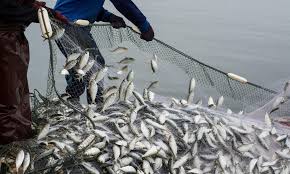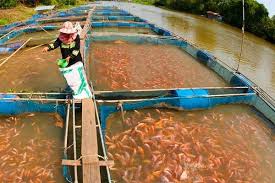The seemingly inexhaustible oceans have proved to be finite after all. Landings of wild fish have levelled off since the mid-1980s, many stocks of fish have been so heavily over-fished that their future is threatened. And yet the world’s appetite for fish has continued to grow, particularly as urban populations and incomes grow in developing countries.
Aquaculture-fish farming has arrived to meet this increased demand. Production of fish from aquaculture has exploded in the past 20 years and continues to expand round the world with rising global production from 99 million tons in 1990 to 122 million tons in 1997.
Despite the surge increase in aquaculture production around the world, there is still the need to intensify effort in the production of fish in order to meet up with the ever growing demand of whose world supply deficit is put at 1 million tonnes by year 2010.
Basically, aquaculture can simply be said to be the raising of aquatic organisms including plants and animals with bias in fish production. The systems can be grouped into three, which is similar to the culture systems of other livestock.
Aquaculture Practices
Fish farming has continued to be a major agriculture activity in most parts of the world transcending beyond riverine activity.
1. Extensive Aquaculture
In this system, fish is raised and is made to depend solely on pond production capacity, yield per unit area is usually low. It is characterised by low inputs, low stocking density and availability of planktons and other live food materials in the pond are aided by fertilisation.
Overall pond yield is very low and is not recommended for large-scale commercial purpose as yield is usually about 500kg per hectare.
Read Also: Evolution and the Study of Fish (Ichtyology)
2. Intensive Aquaculture
This system makes use of supplemental (or artificial) feeds. Usually, high level protein rich diet is employed in order to meet up with nutritional requirements of fish.
Other management practices are equally made to be intensive, which include medication, constant good water quality supply (flow through or Recirculatory system) thereby resulting in high yield per unit area. Yield can be up to 50 tonnes or more per hectare.
3. Semi-Intensive Aquaculture
Under this system, ponds are fertilised in order to enhance phytoplankton growth and supplemental (artificial) feed is also applied which may occasionally be in small quantity. It may not be a pelleted feed in most cases as in intensive system but in the form of locally available or organic wastes-kitchen wastes, brewery wastes, rice bran, groundnut cake e.t.c. Yield is usually moderately higher than in extensive system but not as huge as in intensive aquaculture system.
2. Purpose of Fish Farming

Unfortunately, the term “fish farming” often suggests large-scale commercial enterprises directed at the production of food fish for marketing in restaurants and supermarkets. This common misconception of fish farming misleads in many respects.
First, many successful fish farming ventures are small, family- run, “backyard-type” operations that produce a limited number of food fish for sale in local markets. Second, many fish farms do not grow food fish at all, but instead rear
(1) Eggs and fingerlings (2-4 inch fish) for sale to food fish producers; or
(2) Fingerling sport fish for stocking in private ponds and streams; or
(3) catchable-sized sport fish for stocking in recreational ponds and fee-fishing waters; or
(4) Bait minnows, frogs, crayfish, worms, and aquatic insects for sale to anglers as fish bait; or
(5) Goldfish, tropical fish, turtles, and other aquatic animals and plants for sale as aquarium pets.
Finally, many successful fish farms are non-commercial, hobby-type operations that simply grow fish for home use and stocking personal recreational fishing ponds.
Of the two major types of fish farming (non-commercial and commercial), growing fish on a non-commercial basis for home-food use or personal recreational fishing is the easiest and least expensive way to begin fish farming. Most fish farmers start small by growing a few fish for fun and expand to large-scale commercial operations only after they gain the necessary skills and experience.
Commercial fish farming is a time-consuming, expensive, high-risk business that requires careful planning, a good understanding of fish biology, and sound business management skills. A careful study of economic considerations, especially product demand, financing, production costs, and marketing should be conducted before investing in a commercial fish farm.
However, in whichever form aquaculture is to be practised, there are certain cultural practices that are crucial towards ensuring high level performance on the farm.
Read Also: Aquatic Environment, Classes of Aquatic Organisms and its Limiting Factors
Read Also: Metabolic Wastes Complete Management Guide

